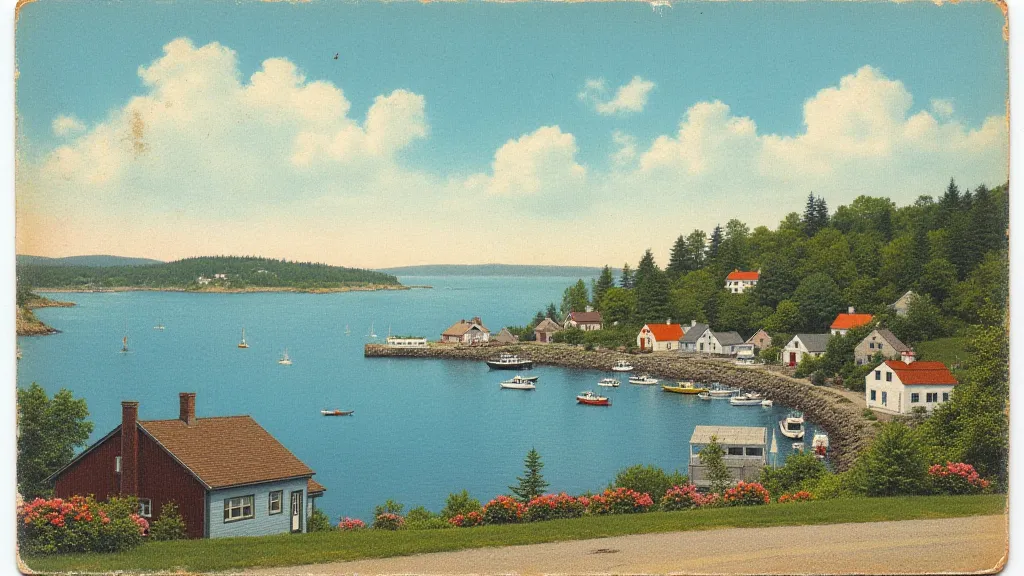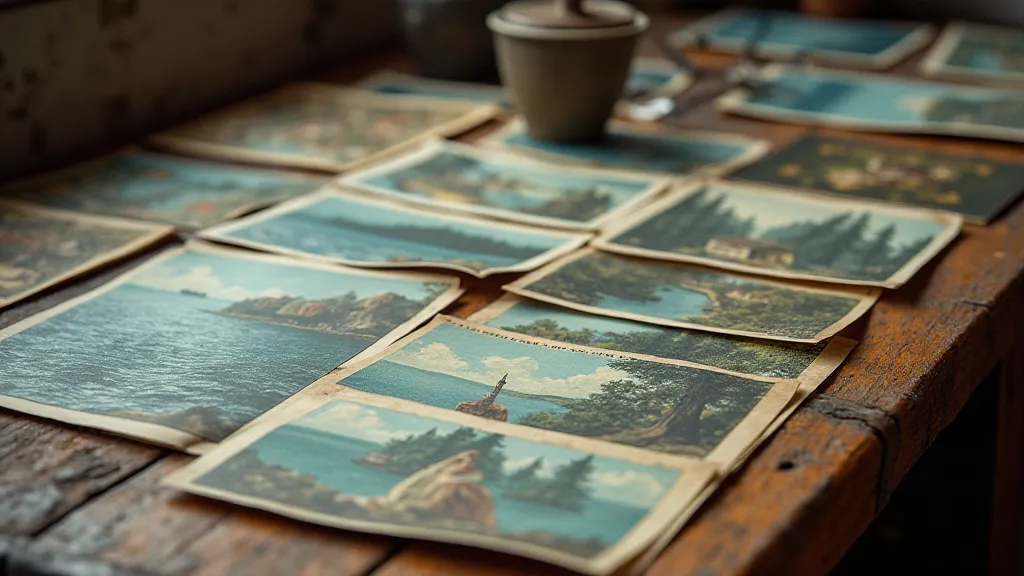The Postcard's Silence: Gaps in the Narrative of Maine's Early 20th Century
There’s a particular scent that clings to old postcards – a fragile mix of aged paper, faded ink, and sometimes, a faint whisper of the glue that held them to a distant sender's hope. Holding one in your hand is more than just touching cardboard; it’s touching a fleeting moment in time, a tiny window into the lives of people who walked Maine’s landscapes a century ago. I inherited a collection from my grandmother, a woman who possessed a remarkable eye for detail and a deep affection for the state’s history. Sifting through those postcards, I’m less captivated by the scenic views they present, and more intrigued by what they *don’t* show.
The Golden Age of postcards, roughly from 1890 to 1920, coincided with a period of significant change in Maine. The state was experiencing rapid industrialization, a burgeoning tourism industry, and a slow, complicated reckoning with its own history – particularly concerning the Wabanaki people and the impact of resource extraction. Postcards, as a rapidly accessible and affordable form of communication and souvenir, became potent visual ambassadors for Maine’s image. But who was crafting that image, and for whom?
The Manufactured Image: Tourism and Idealization
Most vintage Maine postcards present an idealized vision: quaint villages nestled beside sapphire lakes, fishermen hauling in bountiful catches, and picturesque farms stretching towards the horizon. The aim wasn’t necessarily to depict reality, but to sell it. Tourists flocked to Maine seeking respite from the urban grind, and the postcard industry catered directly to that desire. These scenes, often printed in vibrant chromolithography, offered a romanticized escape. They emphasized the perceived purity and simplicity of rural life, deliberately downplaying the realities of poverty, hard labor, and the often-precarious existence of those who actually lived those lives.

Consider the depiction of Maine's forests. While the postcards often showcase majestic pines and sweeping vistas, they rarely acknowledge the devastating impact of logging – the clear-cutting, the erosion, the displacement of wildlife and people. The focus remained on the beauty of the remaining timber, an aesthetic that conveniently ignored the cost of that beauty. Similarly, the portrayal of Maine’s coastline often glosses over the challenges faced by the fishing communities – the fluctuations in fish populations, the impact of industrial pollution, the vulnerability to storms. The ease with which images were reproduced and disseminated meant that these idealized views quickly became the standard representation, overshadowing the often-harsh realities of daily life. It’s fascinating to consider how this mass-produced imagery froze moments in time, creating a nostalgic, yet often inaccurate, perception of Maine’s past, almost as if frozen in time.
The Absence of Labor: Who Built This Paradise?
One of the most striking omissions in many vintage Maine postcards is the absence of the people who made the scenes possible. Where are the mill workers sweating over the machinery? Where are the farmers toiling in the fields? Where are the women who kept the homes and communities thriving? Their presence is conspicuously absent, erased from the picture to maintain the illusion of effortless beauty. The postcard narrative reinforces a class structure, celebrating the leisure of the tourists while silently acknowledging the labor of those who served them.
This wasn’t simply an oversight. It was a deliberate choice driven by market forces and societal biases. Postcards were marketed to a predominantly middle and upper-class audience who wanted to associate Maine with tranquility and luxury, not with the realities of industrial labor or rural hardship. Showing the “working class” didn’t fit the desired image. The idyllic scenes, often captured in specific locations along the coast or near burgeoning industrial centers, were carefully curated to appeal to a specific demographic, often overlooking the very individuals responsible for the region’s economic growth. The sense of serenity presented on these cards belies a much more complex narrative of economic disparity and relentless work.
The Silenced Voices of the Wabanaki People
The omissions extend beyond class and labor to a profound and painful disregard for the history and presence of Maine’s Indigenous people, the Wabanaki Confederacy. Before European colonization, the Wabanaki thrived for thousands of years, shaping the landscape and culture of the region. Yet, their story is largely absent from the postcard record. While some early postcards depict Native American figures, these are often romanticized and stereotypical representations, perpetuating a distorted view of Wabanaki history and culture. They rarely portray the realities of displacement, forced assimilation, and the ongoing struggle for sovereignty.
The silence speaks volumes. It underscores the colonial mindset that dominated Maine during the postcard era, a mindset that actively sought to erase the Wabanaki from the historical narrative and claim the land as solely belonging to newcomers. It's a stark reminder that historical documentation, even seemingly innocuous items like postcards, is never truly objective. These absences aren't mere mistakes; they are deliberate acts of exclusion, reflecting a systematic effort to rewrite the history of Maine to favor the interests of the dominant culture. The selective presentation of the past, with its glaring omissions, highlights the challenges in reclaiming a complete and accurate historical understanding of the region. Consider, for example, the impact of these omissions on those who experienced them - a kind of lighthouse keeper’s lament, a sense of isolation and erasure from the collective memory.
The Craftsmanship and Preservation
Despite the biases and omissions they represent, vintage Maine postcards remain remarkable artifacts of their time. The craftsmanship involved in their production is often impressive. The lithography, the intricate details, the color palettes – all demonstrate a level of artistry that’s often overlooked. Today, many collectors are investing in restoring these cards, carefully cleaning them and reattaching any missing fragments. This preservation effort isn't just about aesthetics; it’s about safeguarding a tangible connection to the past.

Restoration requires a delicate touch. Harsh chemicals can damage the paper and fade the colors. The goal is to stabilize the card and prevent further deterioration, not to erase its history. Collectors often recommend storing postcards in acid-free sleeves and albums to protect them from moisture and light. Understanding the historical context of these cards, their limitations, and the biases embedded within them, becomes crucial during the restoration process. It's about appreciating not just the visual appeal but also the story they tell, even in their silence. It requires a discerning eye, capable of recognizing the layers of meaning and the echoes of the past that resonate within each faded image.
The Echoes of Communication
Beyond the images themselves, the act of sending and receiving postcards reveals another layer of the era’s social fabric. The carefully chosen messages, often brief and sentimental, offer glimpses into personal relationships, travel experiences, and the hopes and dreams of individuals. The very act of relying on this relatively new technology – the postal service – speaks to a changing world, a world increasingly connected by communication networks. The cursive scripts and carefully penned messages represent a lost art, a personal touch that is often absent in today's digital communications. These tangible connections, preserved on fragile paper, offer a poignant reminder of a time when communication was more deliberate and meaningful.
Reading Between the Lines
The true value of vintage Maine postcards lies not just in their visual appeal but in their ability to prompt critical reflection. By recognizing the gaps in the narrative, by understanding the biases and omissions that shaped their production, we can gain a more nuanced and complete understanding of Maine’s early 20th-century history. These seemingly simple pieces of cardboard offer a powerful lens through which to examine the complexities of class, labor, colonialism, and the construction of identity. Each faded image is an invitation to ask: who was here? What stories remain untold? What silences do we need to listen to? It's a fascinating puzzle, piecing together fragments of the past, acknowledging the missing pieces, and recognizing that the story told by these postcards is only part of the larger, more complex reality. The enduring appeal of these artifacts lies not in their romanticized depictions but in their ability to spark conversation and challenge our assumptions about history. The skill required to create these images, from the artistry of the lithographers to the careful penmanship of the senders, speaks to a dedication and attention to detail that is often lost in our fast-paced digital age. This considered approach to communication and artistry highlights another dimension of the era's cultural values.
My grandmother’s collection isn’t just a collection of pretty pictures; it's a fragmented puzzle of a past that demands to be re-examined and reinterpreted. It’s a reminder that history is never complete, and that the most valuable lessons often lie in what we *don’t* see. The fleeting nature of these images and the fragility of the paper they are printed on underscore the importance of preserving these tangible links to the past. Understanding that these postcards offer a selective view of a bygone era—a story carefully constructed and deliberately presented—requires a willingness to look beyond the surface and to critically analyze the messages they convey.






